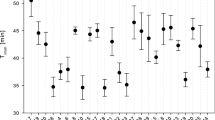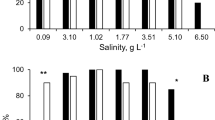Abstract
Aquatic invertebrates are usually larger at maturity when water temperatures are lower. For the freshwater cladoceran Daphnia, it has been suggested that a threshold size must be attained to initiate maturation, which results two instars later in the deposition of eggs into the brood chamber. This threshold size is believed to temperature on maturation threshold body-length in Daphnia magna. Daphnids were raised from birth to maturity under three constant-temperature regimes (12°C, 16°C, 22°C), and two food-level conditions. Animals were measured daily, and a body-length based maturation threshold determined for each individual. We demonstrate that mean maturation threshold length is negatively correlated with ambient water temperature. Further, daphnids with a larger threshold length tended to be larger at maturity. A maturation threshold linked to body length suggests that reduced variation in size at maturity is adaptive, even at the cost of additional variation in instar number or age at maturity.
Similar content being viewed by others
References
Bengtsson J (1986) Life histories and interspecific competition between three Daphnia species in rockpools. J Anim Ecol 55: 641–655
Bernardo J (1993) Determinants of maturation in animals. Trends Ecol Evol 8: 166–173
Brooks JL, Dodson SI (1965) Predation, body size and composition of plankton. Science 150: 28–35
Culver D (1980) Seasonal variation in the sizes of birth and at first reproduction in Cladocera. In: Kerfoot WC (ed) The evolution and ecology of zooplankton communities. University Press of New England. Hanover, pp 358–366
Ebert D (1991) The effect of size at birth, maturation threshold and genetic differences on the life-history of Daphnia magna. Oecologia 86: 243–250
Ebert D (1992) A food-independent maturation threshold and size at maturity in Daphnia magna. Limnol Oceanogr 37: 878–881
Ebert D (1994) A maturation size threshold and phenotypic plasticity of age and size at maturity in Daphnia magna. Oikos 69: 309–317
Enserink EL, Kerkhofs MJJ, Baltus CAM, Koeman JH (1995) Influence of food quality and lead exposure on maturation in Daphnia magna: evidence for a trade-off mechanism. Funct Ecol 9: 175–185
Gophen M (1976) Temperature dependence of food intake, ammonia excretion and respiration in Ceriodaphnia reticulata (Jurine)(Lake Kinneret, Israel). Freshwater Biol 6: 451–455
Green J (1956) Growth, size and reproduction in Daphnia (Crustacea: Cladocera). Proc Zool Soc Lond 126: 173–204
Gross CH, Ranum LPW, Lefebure PA (1988) Extensive restriction fragment length polymorphisms in a new isolate of Chlamydomonas reinhardtii. Curr Genet 13: 503–508
Klüttgen B, Dülmer U, Engels M, Ratte HT (1994) ADaM, an artificial fresh-water for the culture of zooplankton. Water Res 28: 743–746
Lehman JT (1988) Ecological principles affecting community structure and secondary production by zooplankton in marine and freshwater environments. Limnol Oceanogr 33: 931–945
Lynch M (1977) Fitness and optimal body size in zooplankton populations. Ecology 58: 763–774
Lynch M (1989) The life history consequences of resource depression in Daphnia pulex. Ecology 70: 246–256
Perrin N (1988) Why are offspring born larger when it is colder? Phenotypic plasticity for offspring size in the cladoceran Simocephalus vetulus (Müller). Funct Ecol 2: 283–288
Perrin N (1989) Reproductive allocation and size constraints in the cladoceran Simocephalus vetulus (Müller). Funct Ecol 3: 279–283
Stearns SC, Kawecki TJ (1994) Fitness sensitivity and the canalization of life history traits. Evolution 48: 1438–1450
Taylor BE, Gabriel W (1992) To grow or not to grow: optimal resource allocation for Daphnia. Am Nat 139: 248–266
Tollrian R (1995) Predator-induced morphological defenses: costs, life history shifts, and maternal effects in Daphnia pulex. Ecology 76: 1691–1705
Yampolsky LY, Scheiner SM (1996) Why large offspring at lower temperatures? a demographic approach. Am Nat 147: 86–100
Zaffagnini F (1987) Reproduction in Daphnia. Mem Ist Ital Idrobiol 45: 245–284
Author information
Authors and Affiliations
Rights and permissions
About this article
Cite this article
Mc Kee, D., Ebert, D. The effect of temperature on maturation threshold body-length in Daphnia magna . Oecologia 108, 627–630 (1996). https://doi.org/10.1007/BF00329035
Received:
Accepted:
Issue Date:
DOI: https://doi.org/10.1007/BF00329035




